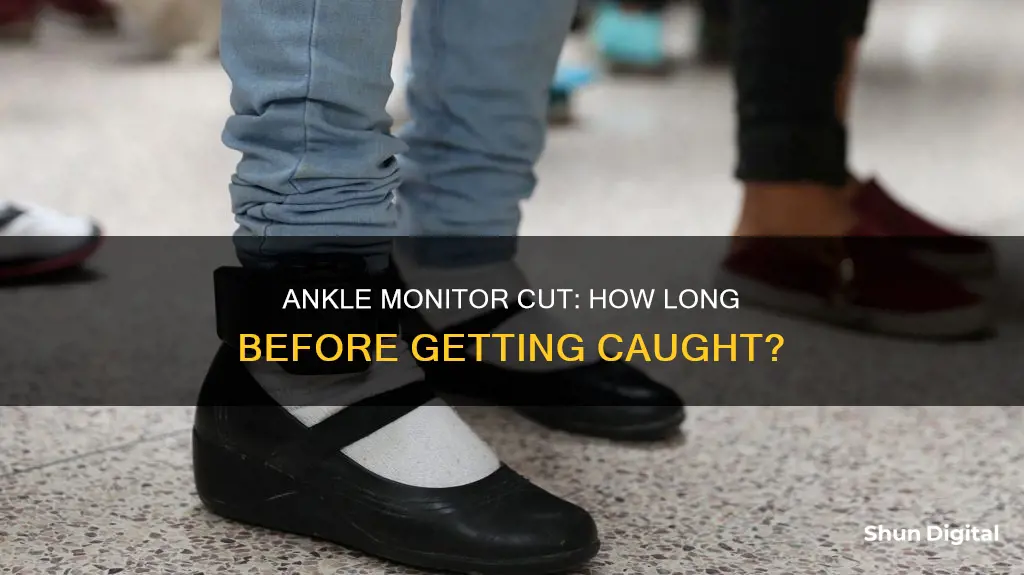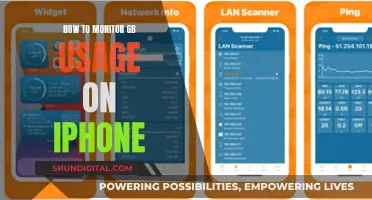
The use of GPS ankle monitors as a form of digital incarceration or e-carceration has been on the rise, with a 140% increase in active monitors between 2005 and 2015. While cutting off a GPS ankle monitor is not impossible, it is certainly challenging, and most devices will notify law enforcement of any tampering. The consequences of removing a court-ordered ankle monitor can be severe, and in some states, it is a crime in itself. The difficulty of removing the monitor means that those who succeed often don't get far before being apprehended.
What You'll Learn

The ankle monitor will likely alert authorities if tampered with
Ankle monitors are designed to be cut off in emergency situations, but they will almost certainly alert authorities if tampered with. Most models have a fibre optic cable that runs through the strap and connects to the box on both sides. If the fibre optic cable does not have a continuous connection, it will alert authorities that the strap has been tampered with. Some models also use internal light sensors to catch anyone who manages to pry open the transmitter's housing.
If you cut off your ankle monitor, you will likely set off an alarm. A radio transmitter embedded in the monitor is programmed to send a distress signal as soon as it's tampered with. Bracelet manufacturers don't usually discuss the specifics of tamper-proofing, but many pieces of monitoring jewellery use a wire that runs the length of the band. Cutting the wire breaks a circuit and sends an alert to the authorities.
In addition to alerting authorities, tampering with an ankle monitor is usually a crime in itself. In Florida, for example, tampering with or trying to circumvent an ankle bracelet is a third-degree felony, punishable by up to 5 years in prison and a $5,000 fine. This conviction also counts toward habitual offender status under Florida law, which can enhance the penalty to up to 10 years in prison.
Even if you manage to cut off your ankle monitor without alerting authorities, it will be very difficult to put it back on later. Parole officers or other supervisors are supposed to examine the bracelets on a regular basis. If they see any signs of tampering, such as cut marks or twisted plastic, the offender is considered to have violated the terms of the monitoring program.
Discovering OIDs for SNMP Device Monitoring
You may want to see also

Removing the monitor may be a crime in itself
Removing an ankle monitor is a serious offence and can result in severe consequences. In most cases, ankle monitors are court-ordered, and tampering with them is considered a crime. In many states, removing an ankle monitor can lead to additional charges and jail time. It is considered a violation of the terms of release and can result in an arrest warrant being issued.
The consequences of removing an ankle monitor can vary depending on the jurisdiction and the nature of the crime. In some cases, removing an ankle monitor may be charged as a separate offence, leading to additional penalties. For example, in the state of Missouri, removing an ankle monitor is considered a felony.
Additionally, private companies often charge defendants daily or monthly fees for wearing the device. If individuals cannot pay these fees, they may end up in further legal trouble. The cost of these devices can be a significant financial burden, especially for those who cannot afford it.
The removal of an ankle monitor can also have implications for the individual's probation or parole status. It may be considered a violation of the terms of their release, leading to further legal consequences.
In summary, removing an ankle monitor is a serious offence that can result in various legal consequences, including additional charges, jail time, and financial penalties. It is important for individuals to understand the terms and conditions of their ankle monitor and the potential repercussions of any tampering or removal.
LG Monitor Buying Guide: Where to Buy?
You may want to see also

It is difficult to cut off a GPS ankle monitor
People have tried to use bolt cutters and blowtorches to remove their ankle monitors, but to no avail. While it is not impossible to remove an ankle monitor, it is challenging and requires a lot of effort. Most courts use a thin rubber cuff, which can be cut using kitchen shears, but even then, most monitors will notify law enforcement if someone tampers with them. So, while it is difficult to cut off the monitor without being detected, it is not impossible. However, the hard part comes after it's already off, as the authorities will be alerted and will be on the lookout for the individual.
Additionally, the ankle is a difficult place to slip the monitor off due to the awkward bulk of the foot. The wrist, for example, is easier to slip off because the thumb and hand can be contorted to make it easier. However, the ankle's bulkiness makes it challenging to remove the monitor without cutting it.
In conclusion, while it is not impossible to cut off a GPS ankle monitor, it is difficult and requires a lot of effort. Most attempts to remove the monitor will be detected, and the authorities will be notified. The design of the monitor and its placement on the ankle also make it challenging to remove without cutting.
Monitor Multitasking: 3-Screen Setup for Ultimate Productivity
You may want to see also

Ankle monitors restrict movement and cause stress and social isolation
Ankle monitors can be restrictive, stressful, and socially isolating. People on court-ordered ankle monitors are often required to remain in their homes unless they obtain approval to leave, which must be sought days in advance and is inconsistently granted even for routine activities. This restriction on movement can make it difficult for individuals to work, attend school, or socialise, leading to social isolation and stress. The devices also capture, analyse, and store months of location and movement data, which is often shared with law enforcement agencies and the courts, further infringing on privacy rights.
The nature and number of rules and restrictions imposed on people wearing monitors can set them up for failure and reincarceration. Technical issues and rule violations that often have nothing to do with public safety can result in a return to prison. For example, failure to keep the device charged or charged for a particular amount of time could land a person back in jail. The rules are often vague, overly broad, and open to interpretation, which can lead to anxiety and panic attacks in the monitored individuals.
Additionally, the stigma associated with wearing an ankle monitor can lead to social isolation and judgment from others. The devices are visible to others, and the monitored individuals may be automatically judged or avoided, as seen in the case of Matthew Brown, who reported that "moms pull kids away" when they see his ankle monitor. This social isolation can exacerbate existing mental health issues and make it difficult for individuals to reintegrate into society.
Furthermore, the financial burden of wearing an ankle monitor can be significant. Most jurisdictions require people on monitors to pay expensive fees for the surveillance devices, which can range from $3 to $35 per day, in addition to initial setup charges of $100 to $200. These costs can amount to hundreds of dollars per month, overburdening households, especially those with other financial responsibilities, such as medical expenses or supporting family members.
The combination of restricted movement, constant surveillance, vague rules, social isolation, and financial burden can lead to stress, anxiety, and depression in individuals on ankle monitors. The devices can make it difficult for people to rebuild their lives and reconnect with their communities, underscoring the need for less restrictive alternatives that respect privacy and promote rehabilitation.
Connecting a Monitor to Behringer Eurorack: Easy Steps
You may want to see also

Ankle monitors can be expensive
The cost of an ankle monitor can be a burden, especially for those who are already struggling financially. Some argue that the use of ankle monitors should be seen as an opportunity for social reintegration and that the cost of these devices may push individuals towards further criminal activity. However, others argue that the cost is justified as it is a consequence of committing a crime.
In some cases, individuals may be given the option to wear an ankle monitor or remain incarcerated. While wearing an ankle monitor, individuals must also follow strict rules, such as regularly charging the device, and failure to comply with these rules can result in additional fees or even jail time.
The cost of ankle monitors can vary, and in some states, the amount an individual is charged is based on their ability to pay. However, in most cases, the EM provider, whether a governmental agency or private for-profit company, has the freedom to set any fee it deems appropriate. This lack of oversight can result in excessive charges for those on electronic monitoring.
The high cost of ankle monitors and the associated fees can create a cycle of debt and punishment that may hinder an individual's ability to successfully reintegrate into society. While the use of ankle monitors can provide an alternative to incarceration, the financial burden associated with them can be significant and may disproportionately impact those who are already facing economic challenges.
Internet Monitoring Software: Is Your Privacy at Risk?
You may want to see also
Frequently asked questions
It is not impossible to cut off a GPS ankle monitor, but it is difficult and will likely take a lot of effort. Most courts use a thin rubber cuff, which can be cut with kitchen shears. However, most monitors will notify law enforcement if someone tampers with them, so the hard part comes after it's already off.
Cutting off a GPS ankle monitor is a violation of the terms of your monitoring and can result in legal consequences. Depending on the state, it may be considered a crime, leading to additional charges or jail time.
GPS ankle monitors use GPS tracking technology to record the location of the wearer. This information can be accessed and monitored by law enforcement or other authorized entities. The monitors typically have a way to detect if the device has been tampered with, such as a fiber optic cable that runs through the strap. If the connection is interrupted, it will trigger an alert.







